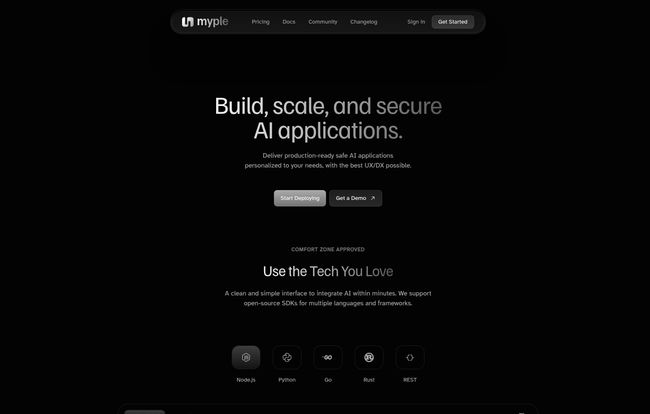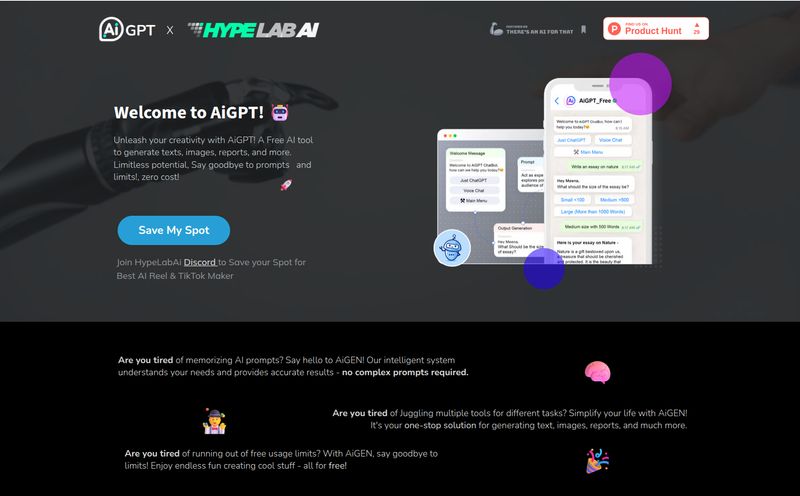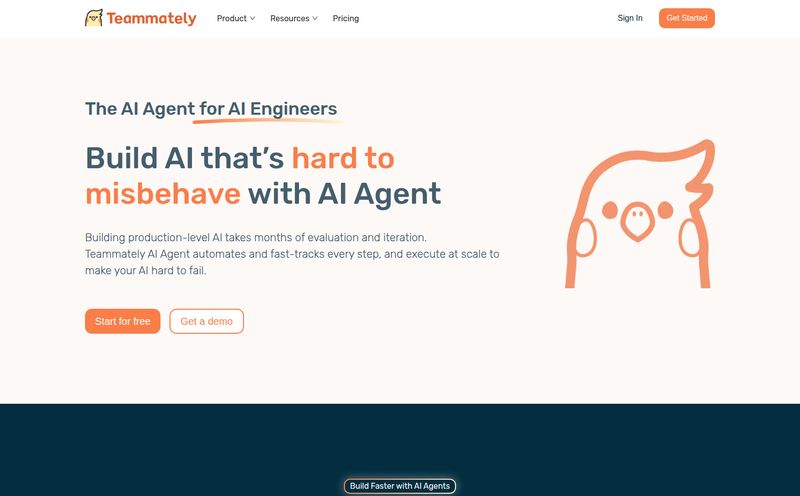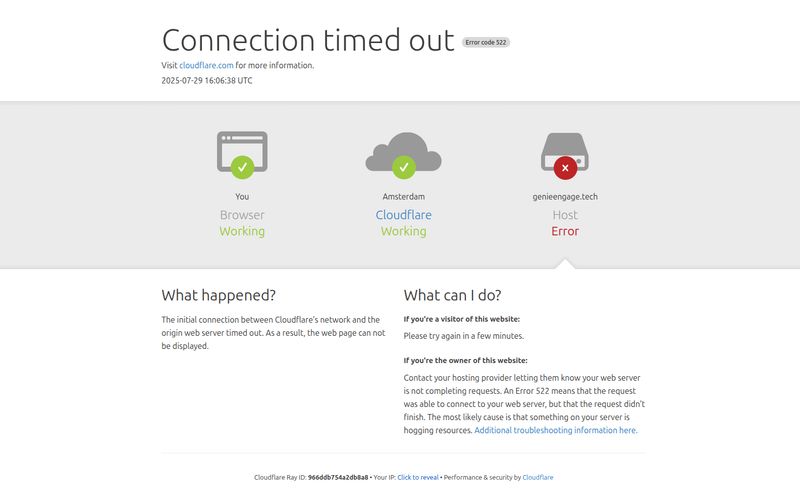The AI gold rush is in full swing. Every founder, product manager, and their dog is trying to figure out how to bolt some GPT-powered magic onto their product. And why not? The potential is huge. But there's a dirty little secret nobody likes to talk about at the pitch meetings: deploying, scaling, and securing these AI applications is a whole different beast. It’s not just about a clever prompt; it’s about infrastructure, latency, security, and a dozen other headaches that can kill a project before it even gets started.
I’ve been in the SEO and traffic game for years, and I’ve seen this pattern before. A new tech wave hits, and a whole ecosystem of tools pops up to make it easier for the rest of us. We saw it with cloud computing (hello, AWS), we saw it with web apps (shoutout to Vercel and Netlify). And now, it seems, we’re seeing it with AI. Which brings me to a new player that recently crossed my desk: Myple.
Their homepage hits you with a pretty bold claim: “Build, scale, and secure AI applications.” Okay, you have my attention. They’re still in a beta program, which can be a mixed bag, but it also means there's a chance to get in on the ground floor of something cool. So, I decided to take a closer look.
So, What Exactly is Myple?
Think of it like this: You have a brilliant idea for an AI feature. Maybe it’s a chatbot that knows your entire product documentation, or an AI agent that can draft emails for your users. You can code the logic, but then what? Do you start spinning up servers, managing Python environments, wrestling with vector databases, and figuring out how to keep it all online and secure? For most of us, the answer is a resounding 'heck no'.
Myple steps into that gap. It’s a platform designed to take the infrastructure nightmare off your plate. At its core, it offers managed AI agents and support for RAG models. If you're not deep in the AI weeds, RAG stands for Retrieval-Augmented Generation. In simple terms, it’s a way to make large language models (like the ones from OpenAI) smarter by giving them access to your own private data. This is how you build a chatbot that can answer specific questions about your business, not just spit out generic facts from the internet.
So, Myple isn’t building the AI models themselves. It's providing the plumbing, the scaffolding, and the safety net to let you use those models effectively in a real-world application. It’s the Heroku or Vercel for the AI layer of your stack. You bring the code, they handle the rest.

Visit Myple
My First Impressions: Getting Hands-On with Myple
The first thing that stood out to me was their emphasis on developer experience. The website is clean, dark-themed (a nod they know their audience), and sprinkled with little touches that matter. They boast about a “dead simple integration,” and from the code snippets, it looks like they mean it. The Node.js example is just a few lines to get a completion. No complex boilerplate, no ceremony. I love that.
And then there are the keyboard shortcuts. Being able to hit 'n' for a new chat or '⌘ K' to bring up a prompt card might seem small, but it shows a deep respect for a developer’s workflow. It’s one of those things that tells you the platform was built by people who actually code for a living. It’s not just marketing fluff; it’s thoughtful design.
The Features That Actually Matter for Developers
A slick interface is nice, but it's the features that determine whether a tool becomes part of my daily workflow or gets forgotten in a folder of bookmarks. Myple has a few things that I think are genuine game-changers.
Templates That Get You Off the Ground Running
Starting from a blank slate is terrifying. Myple seems to get this. They offer pre-built templates for common AI use cases. I saw one for building a RAG chatbot on your documentation, an AI agent inside Gmail, and something called “AskFeynman,” an AI-powered personal assistant. This is brilliant. It lowers the barrier to entry from “I need to be an AI expert” to “I can follow a template.” It lets you get a proof-of-concept running in hours, not weeks, which is everything in a fast-moving market.
Managed Infrastructure is a Godsend
I cannot overstate how important this is. The promise of “hassle-free” managed services is the core value proposition here. Not having to worry about scaling your vector database or ensuring your AI agent is always online is huge. This is what allows a small team or even a solo developer to build something that can compete with the big guys. It lets you focus on what makes your application unique, rather than becoming an unwilling, unpaid sysadmin.
Speak Your Language (No, Really)
Right now, Python seems to dominate the AI conversation, but not every team is a Python shop. Myple shows support for Node.js, Python, Go, and Rust. This flexibility is critical. It means you can integrate their tools into your existing tech stack without having to hire a whole new team or learn a new language from scratch. It’s a practical, inclusive approach that I wish more platforms would adopt.
Let's Talk Money: Myple's Pricing Breakdown
Alright, the all-important question: what’s this going to cost me? You do have to click over to their pricing page to see the numbers, which is a minor pet peeve of mine, but at least they're transparent once you get there. The structure is pretty familiar and, in my opinion, very well thought out.
Here’s a quick look at their plans:
| Plan | Price | Who It's For | Key Features |
|---|---|---|---|
| Hacker | Free | Solo devs, hobby projects, testing | 2 Applications, 1 Database, 1-day data |
| Team | $29 /user/month | Startups and small teams | 10 Applications, 5 Databases, 7-day data, Priority Support |
| Scale | Custom | Established companies | Unlimited everything, SOC 2, SAML, SLA |
The Hacker plan is a proper free tier, not just a 14-day trial. This is the right way to do it. It gives you enough resources to actually build and test something meaningful. The Team plan feels like the sweet spot for most businesses, offering a solid jump in resources and priority support for a pretty reasonable price. And the Scale plan is there for the big leagues, with all the enterprise-grade acronyms (SOC 2, SAML, SLA) that make legal and security teams happy.
The Good, The Bad, and The Beta
No tool is perfect, especially one that's still in beta. So here’s my balanced take. The good is obvious: the simplicity, the developer-first mindset, the powerful templates, and the managed infrastructure are all huge wins.
But what about the downsides? One might be the reliance on Myple's platform. When you build on a platform like this, you are, to some extent, tying your horse to their wagon. This is the age-old platform vs. self-hosted debate. Personally, I think for 95% of teams, the speed and convenience you gain far outweighs the risk of platform lock-in. You need to get to market, not build a perfect, portable infrastructure from day one.
The other “con” is that some features are in beta and could change. To me, this is actually a pro disguised as a con. Being an early adopter means you get to use cutting-edge stuff, and more importantly, you often get a chance to give feedback that actually shapes the future of the product. It’s a trade-off: you might encounter a few more rough edges, but you get a say in how they get polished.
Who is Myple Actually For?
After digging in, I have a pretty clear picture of who would get the most out of this.
- The Indie Hacker or Solo Developer: The free Hacker plan is your new best friend. It’s a complete playground to bring your AI side-project to life without spending a dime on infrastructure.
- The Fast-Moving Startup: The Team plan is practically made for you. Your goal is to ship features and find product-market fit, not become an expert in Kubernetes. Myple lets you do just that.
- The Established Enterprise: If you're at a larger company looking to innovate without disrupting your core infrastructure, the Scale plan offers a secure, compliant, and powerful way to experiment and deploy new AI features.
My Final Verdict on Myple
So, is Myple the missing piece of the puzzle? For a lot of teams, I think the answer is yes. It’s a thoughtfully designed platform that solves a very real, very painful problem. It removes friction. It lets builders build and creators create, without getting bogged down in the complex, unglamorous work of infrastructure management.
It's still early days for them, but the foundation is incredibly strong. They understand their audience, they're focused on the right problems, and they’ve built a product that feels both powerful and easy to use. I’m genuinely excited to see how Myple evolves, and I’ll definitely be keeping it in my toolbox for future AI projects. It just might be the tool that turns your next great AI idea into a reality.
Frequently Asked Questions about Myple
- What is RAG and why does Myple focus on it?
- RAG, or Retrieval-Augmented Generation, is a technique that lets AI models access external knowledge (like your company's documents) before answering a question. Myple focuses on it because it's the key to creating AI applications that are truly helpful and specific to a user's context, rather than just being a generic chatbot.
- Is the Hacker plan really free forever?
- Based on their pricing page, yes. The Hacker plan is a free tier designed for smaller projects and personal use. It’s not a time-limited trial, though its resource limits (like 2 applications) apply.
- What happens if I send more requests than my plan allows?
- Their on-page FAQ suggests you'd need to upgrade your plan. Most platforms have a system to notify you as you approach your limits to prevent service interruptions, and it's likely Myple does as well. For specifics, you’d probably want to check their documentation or contact support.
- What kind of support can I expect?
- The Hacker and Team plans come with Community Support. The paid Team plan adds Priority Support, meaning your queries get looked at faster. The enterprise-level Scale plan comes with a dedicated Service Level Agreement (SLA), implying a much higher, contractual level of support.
- Is Myple suitable for production applications?
- Absolutely. While it's in beta, the entire platform is designed around building, scaling, and securing production-ready applications. The tiered plans, especially Team and Scale, offer features like DDoS mitigation, priority support, and SLAs specifically for live, customer-facing products.



